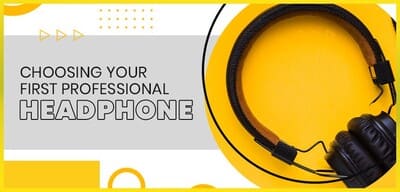Choosing your First Professional Headphone
A professional headphone is quite different than using a headphone for your mobile device or casual music listening. You would be surprised to see that they sound completely in contrast to each other. Now that we know for a fact, consumer headphones and studio headphones are different. It brings us to another big question – which studio headphone to choose?
Brand/colour/wired or wireless… Honestly, none of those matters.
There are a few aspects to keep in mind before choosing the right one that suits you.


Purpose:
The first step in choosing a professional headphone is to know the purpose of the operation. The headphone would either be used for mixing or music composition and mixing or production, mixing and mastering. A single headphone can support not all these aspects. For example, while tracking a drum kit, the drummer should be provided with a well-isolated headphone that aids him to hear the click track prominently isolating it well from all the background noise. Whereas a mix engineer works in a closed environment, he doesn’t require a lot of isolation and using such headphones allows him to use them for a more extended period.
Different headphone types:
Here we are about to understand different headphone designs used for a particular purpose or reason.
- Open Back Headphones:
They have their back fully open which helps release the sound pressure that generates inside the headphone enclosure. Predominantly used for mixing purposes as there are significantly fewer reflections inside. This results in getting accurate frequencies compared to other headphones. Keep in mind other factors affect the reflection of frequencies. So, don’t judge any headphone just on the open back feature.
- Closed-Back Headphones:
These are opposite to Open Back Headphones, where their enclosure is closed completely. This type of headphone is used for monitoring purposes. Especially Drum or Vocal monitoring by a Drummer or a Vocalist. The advantage of using such headphones is that it helps in isolation and allows less noise from the outside than open-back headphones. When such headphones are used in a vocal booth with a condenser microphone which is highly sensitive. It helps by not recording the headphone spill into the microphone. Especially prominent noises like a click (metronome) track. Some engineers recommend using closed-back headphones for mixing because it gives them good results. This is scarce with many suggesting its entirely not suitable for a longer span of period.
- Semi-Open Headphones:
Semi-Open Headphones are one of the best types of headphones to use it both for mixing and monitoring purposes. These headphones are partially open from the back to release extra sound pressure but are not as noisy as open backs. Most engineers prefer this from monitoring and mixing as you don’t need separate headphones to aid your purpose.
Accuracy and Comfort:
When it comes to closed-back, open back or semi-open back, the end goal is to achieve an excellent professional mix. This quality ultimately depends on two aspects – skillset and equipment. Without adequate equipment, you will not acquire the right frequencies, no matter how skilled you are. Choosing a headphone with a flat spectrum helps to achieve this. Remember, as flat as the frequency spectrum; the good is your mix.
When comfort comes in place, it depends on the engineer or producer to choose a headphone that fits him the best; allowing him to use it for more extended periods, or he/she will feel tired and discomfort.
Open-back headphones can be very comfortable because the pressure generated inside the enclosure gets out from the back, making listening feel as comfortable as you are listening from monitors. But if you are comfortable using closed-back headphones, remember to take breaks from them during long sessions.
Durability:
Durability plays a significant role when it comes to choosing your headphone. It’s best to hold on to your current headphone till you save up for an expensive and a more proven model.
Two things to keep in mind are,
- Pick a better (professional) brand.
- Avoid purchasing newly launched headphones. Instead, go for a tested model with a history.
Connection:
Choose your headphone carefully depending on the connector type 1/4″ phono or 1/8″ phono, wire type/length and cable quality. These three key points will help you choose a model wisely that suits your requirement.
Need for Headphone Amp:
Most of the interfaces come with either one or two built-in headphone amp outputs. But if you have more than one headphone and if your audio interface has not more than one out. Using two headphones simultaneously will degrade the quality. Especially when you are mixing or mastering; to solve this, consider buying an external headphone amp to solve the quality loss.
Considering all the factors mentioned above, I’m sure choosing your first professional headphone cannot go wrong. Good luck!
– Roger Walker
Faculty – Sound Engineering, Seamedu School of Pro-Expressionism, IND.


CATEGORIES
Are you aspiring to become a proficient Sound Engineering professional?
Look no further; we are committed to nurturing the potential of young minds. Are you ready to enhance your skills?

